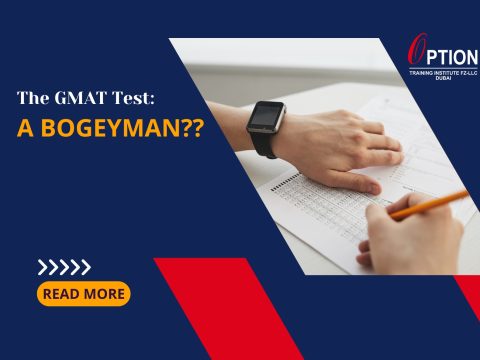- For Enquiry -
- +971 509267126
- +971 551207626
- enquiry@optioneducation.ae
It would be ‘unfair’ to both the test and the test takers to answer this question conclusively and deem one the culprit and the other the victim. The reality is that, as with anyone seeking to achieve proficiency in a language for a formal exam, many parameters go into making the effort either fruitful or fruitless.
First, what has been the test takers’ prior exposure to the language? In this case, English. Most non-native users of English have been exposed, for varying lengths of time, to English as a school curriculum subject rather than thereafter. More often than not, this exposure is very bookish and focuses more on completing a syllabus than on cultivating life-long skills with the language.
Some hurried introduction to grammar, a cursory effort to make students do some writing, and a clear negligence of the need to encourage an inclination for reading are what this exposure normally turns out to be. As a result, when the user needs the language later for college-level courses, for standardized tests such as the GMAT, or his career, there is a clear deficiency, and he has no choice but to get down to correcting it.
This means a late interface with the language. Trying to learn correct grammar, to read and understand the content, to grasp the nuances of English after one has neglected it for a long is not easy; the learner’s understanding of English has taken shape, and it is difficult to expect him to receive more information readily and with advantage.
So, before answering how unfair the GMAT is with non-native speakers of English, evaluate yourself and identify whether you have a ‘basic’ understanding of English since that is a prerequisite for attempting the test.
The GMAT tests math and verbal skills, and just as there is a level of Math, there is a level of Verbal. Apprise yourself of this level and take on the challenge only after you are sure you are up to it, or give yourself sufficient time and the right training. Most often, students fight the battle with the wrong or no weapons, which is their undoing.
Second, did the test taker make sufficient contact with the GMAT through practice? Test takers, sadly, are people in a hurry. Because individuals taking the GMAT are professionals, they are short on time and must finish the exercise as soon as possible.
That is where their debacle with the test starts. The paucity of time forces them to rush through material, complete a training schedule at any institute training for the test, and take an odd practice test before taking on the real GMAT.
This kind of preparation is a sham in the name of preparation, especially for non-native users, and can expose them to only the broad rules used on the test- parallelism, subject–verb agreement, modifiers, and tenses. How does the test taker gain exposure to the finer nuances employed by the test?
Two such nuances are particularly unsettling for non-native users- the sentences centered around an idiomatic structure and those with practically no grammar error but are constructed to test the test takers’ understanding of the ‘sense’ conveyed. Debate has been rife since 2011 about GMAT doing away with idioms, but nothing like that has happened.
How can an important tool of expression, the idiom, be done away with from a language? And how can one expect to learn a language without understanding how different constructions of the same content can convey different meanings? The GMAT is simply testing English ‘proficiency,’ and anyone taking on the challenge must be ready to be tested in all aspects of the language and not feel ‘victimized’ or disadvantaged.
The GMAT is doing what it is supposed to be doing – testing preparedness for business school programs by testing Math and English comfort levels; the test taker should be ready to do what he is supposed to prove this preparedness.
Important: A discussion of sentences testing ‘sense’ next week will throw more light on what the GMAT expects of the test taker and illustrate how far one’s preparation for the GMAT needs to go.
GMAT preparation in Dubai is available at Option Training Institute in Knowledge Village. All the courses, group and one-on-one, have been designed to cater to the differing language levels of test takers. Trainers at Option have conceived unique ways to help students acquire comfort with the test. Detailed class discussions cover the common error types and introduce concepts –idioms, redundancy, verbosity, active voice versus passive voice- that students and trainers often overlook while preparing for the test.
- Filter by
- Categories
- Tags
- Authors
- Show all
- All
- ACT
- ACT Essay
- ACT Exam
- ACT Experts
- ACT Prep
- ACT Preparation
- ACT Test
- ACT Test Takers
- ACT Training
- ACT Writing Section
- Algebra
- AP
- AP AB
- AP BIOLOGY EXAM
- AP Calculus AB
- AP Classes
- AP Course Prep
- AP Dubai
- AP Exam Test
- AP Exams
- AP Test
- c-trap
- Chemistry Subject SAT
- Class Schedules
- Concepts
- COVID 19
- Digital SAT
- DIGITALSAT
- DSAT
- EVEN
- Factors
- GEOMETRY
- gmat
- GMAT MATH
- GMAT Prep
- GMAT Preparation
- gmat quant
- GMAT Scores
- GMAT Section
- gmat test
- GMAT VERBAL
- GMAT Verbal Section
- GRE
- GRE Prep
- GRE Test
- INSEAD
- Junior SAT
- LNAT
- Math
- mathematics
- MBA
- MBA Program
- Multiples
- New SAT
- NEW SAT ESSAY
- Number Properties
- NUMBERS
- Objectives of AP
- ODD
- Option
- QS Event
- Remainders
- SAT
- SAT Biology
- SAT BIOLOGY E/M
- SAT CANCELLATION
- SAT Chemistry Subject Test
- SAT Dubai
- SAT Essay
- SAT Exam
- SAT Grammer
- SAT II
- SAT Language Section
- SAT MATH
- SAT Prep
- SAT READING SECTION
- SAT Subject
- SAT Subject Test
- SAT Test
- SAT Test Takers
- SAT Trainers
- SAT Writing
- SAT Writing Section
- Skills
- Starting Classes
- Subject SAT
- Subject SAT Math Level 2
- Subject Test
- Test Prep
- Test Takers
- Training Institute
- Triangles




